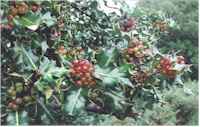
![]()
Tinne
Holly (July 8 - August 4)

The botanical name for English Holly is Ilex aquifolium. This tree grows to a height of fifty feet. The diameter of it's trunk is approximately one and a half feet. It blooms in Spring (white, star shaped flowers) and bears shiny red berries in Autumn, which last throughout the Winter. The leaves are shiny, dark green, elliptical and have spiny points. In order to produce berries, both a male and a female tree are required. Only the female tree produces berries and, to do so, must be pollinated by the male tree. The berries, although lovely, are poisonous.
As a general rule, Holly is considered masculine, although there is also a female Holly tree. As an Evergreen, it also represents Immortality. Holly is Sacred to Lugh and to Habondia, the Goddess of Plenty. It is one of the Nine Sacred Woods used in Need-Fires (Oak, Pine, Holly, Hazel, Juniper, Cedar, Poplar, Apple and Ash). In ancient Irish Law (Crith Gablach, Seventh century) it is also listed as one of the Noble Trees of the Grove (Birch, Alder, Willow, Oak, Holly, Hazel, Apple). Holly has a fine white wood that was used in the past in inlays and for walking sticks and riding crops. The Celts fashioned spears from the protective, strong wood of the Holly tree.
Holly was particularly sacred to the Druids, who instructed people to take it into their homes in Winter, to give shelter to Elves and Fairies during the cold weather. They also warned against keeping even one leaf inside after Imbolc and said that to do so brought about misfortune. In ancient Rome, gifts of Holly were given during the Saturnalia celebration (Winter Solstice). Holly as decoration for Yule celebrations is common to many cultures. The image of the Holly King is familiar to most of us and has been personified in film as The Ghost of Christmas Present in several versions of Charles Dickens' 'A Christmas Carol'.
Robert Graves speculates, in 'The White Goddess', that the English Holly is a late replacement for the Kerm-Oak or Holly-Oak. This is doubtful, because the Holly-Oak isn't native to Britain. He also examines the possibility that the two trees (Ogham letters D and T) represent the Oak Knight and Holly Knight, who traditionally battle every first of May for the hand of the Goddess, Creidyllad. His theory is that these two are the 'Lily-white boys, clothed all in Green-O' mentioned in the song 'Green Grow the Rushes-O'. Graves does make one major mistake in stating that the Holly blooms during the month of July, when it actually blooms much earlier. July is when the beautiful green berries quite suddenly appear on the Trees. (see photo).
Traditionally, a branch must not be cut from a Holly tree, but must be pulled off. It is considered unlucky to cut or burn Holly, but is lucky to hang a small branch left from the Yule decorations outside the house. This will protect against lightening and bring good fortune.
 Actually, Holly was a seen as a strong protective herb, guarding against 'evil
spirits and short-tempered Elementals, poisons, thunder and lightening'. The idea of
protection against lightening has basis in fact, as it has been shown that the spikes of
Holly leaves act like miniature lightening conductors, granting immunity to the trees.
It's ruling planet is Mars and it's Element is Fire. As a Magickal herb, Holly brings
clear wisdom and courage. It is also useful for dream Magick.
Actually, Holly was a seen as a strong protective herb, guarding against 'evil
spirits and short-tempered Elementals, poisons, thunder and lightening'. The idea of
protection against lightening has basis in fact, as it has been shown that the spikes of
Holly leaves act like miniature lightening conductors, granting immunity to the trees.
It's ruling planet is Mars and it's Element is Fire. As a Magickal herb, Holly brings
clear wisdom and courage. It is also useful for dream Magick.
There is a spell from the North country of Britain, which uses Holly to promote divination by dreams. A young girl gathers nine leaves of 'she-holly' (smooth, rather than prickly) at midnight on a Friday. She then ties them into a three-cornered handkerchief, using nine knots. Placing it under her pillow, she may then dream of her future husband. Another version of this spell dictates that the leaves must be collected in silence and bound in a white cloth (again using nine knots). This, when placed under the pillow, makes dreams come true.
Speaking of 'she-holly', it is believed that if smooth 'she-holly' is brought into the house first, at Yule, the wife will rule the household during the coming year. If prickly Holly, or 'he-holly' is brought in first, the husband will rule. It is also said that if a man carries a Holly leaf or berry on his person, he will become attractive to women.
An old custom that can be fun to carry out today involves placing bits of candle on Holly leaves, lighting them, and floating them in a tub of water. Each person makes a wish on their leaf. If the candle stays lit, the wish will come true! One more power is given to the Holly. According to Pliny, the wood, when thrown in the direction of any animal, will compel the animal to obey. Holly can also be used in meditation to calm the mind and body.
The one thing that is certain is that the ancients saw this tree as especially sacred and that 'of all the Trees that are in the Wood, the Holly bears the Crown'!



